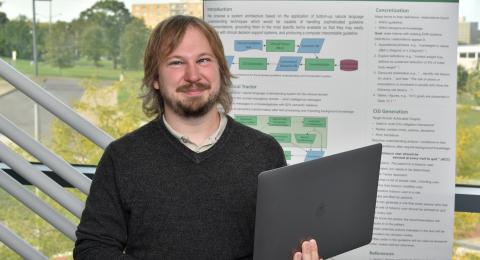Grant supports professor's artificial-intelligence effort to improve healthcare
Office of Communications and Marketing
Published
Thanks to a grant from the National Institutes of Health, SUNY Oswego computer science faculty member Daniel Schlegel plans to apply artificial intelligence (AI) to an immensely complex problem: the automated interpretation of guidelines for medical treatment of diseases.
The three-year, $325,000 grant from NIH's National Library of Medicine paves the way for Schlegel to work on the project with Oswego students, aided by mentorship and consulting from clinicians and researchers at Roswell Park Comprehensive Cancer Center in Buffalo, University of Haifa in Israel and University College Cork in Ireland.
The documentation for treating each disease can run to hundreds of pages, Schlegel said. Ultimately, way down the road, the project will integrate computer-interpreted guidelines with electronic health record systems, putting into doctors' hands -- at the time of care -- the keys to resolving sometimes contradictory guidelines for treatment of patients with multiple diseases and other health issues.
"Doctors use clinical practice guidelines to decide how to treat people with different disorders," said Schlegel, who earned both his undergraduate degree in computer science (2008) and his master's degree in human-computer interaction (2009) at SUNY Oswego before obtaining his doctorate in computer science and engineering at University at Buffalo. "They exist for every different type of disease. They sometimes use pretty fuzzy language, for example, 'You may perform this procedure …'"
Schlegel has chosen guidelines for four categories of disease to start with: diabetes, non-small cell lung cancer, prostate cancer and those for patients who've already had cardiac events and need to reduce the risk of further problems.
"Humans can't memorize all of this," he said. "How can we make it so they have immediate access to information, in a good way, and hopefully have computers help with that?"
What is 'normal'?
Schlegel and his team have to build a general representation, working to make it useful for many sets of guidelines. The computer will then "read" the guidelines into that representation, using natural language understanding techniques.
There also needs to be a set of definitions. For example, what is "normal" blood sugar? The definition of what's normal may be in a table in a separate resource, he said, "so we need to connect these things somehow."
Schlegel provided an example of fuzziness in a guideline: "Patients should be assisted by counseling and by development of a plan for quitting (smoking) that may include pharmacotherapy and/or referral to a smoking cessation program. (Level of Evidence: A)"
Words such as "should" and "may" are conditional and less restrictive than the word "must," which isn't used in guidelines. Besides finding a way for a computer to deal with that, there also would need to be an explicit link to a definition for "levels of evidence" -- such as research studies -- supporting the guideline.
The project, while formidable, promises eventually to reduce treatment mistakes and make for more consistent clinical decision-making.
Others, too, are at work in the field. For expert assistance, Schlegel has enlisted Carmelo Gaudioso, a researcher at Roswell Park working with systems supporting physicians' clinical decisions; Mor Peleg, a professor of information systems at University of Haifa who has worked on computational representations of medical treatment guidelines for years; and Selja Seppäläat University College Cork, an expert in dealing with computer-interpretable definitions.
Schlegel said SUNY Oswego students -- four during the academic year and three each summer -- would have the opportunity to work with him on the project and to travel to Buffalo to meet with Gaudioso. A couple of students would travel to Haifa with Schlegel to work with Peleg.
During Schlegel's doctoral work in computer science and engineering at University at Buffalo, he worked on language understanding of intelligence messages for military applications. Then, during his post-doctoral work in biomedical informatics at UB, he became interested in medical treatment guidelines.
"It seemed like a place where artificial intelligence could make a difference," he said.



